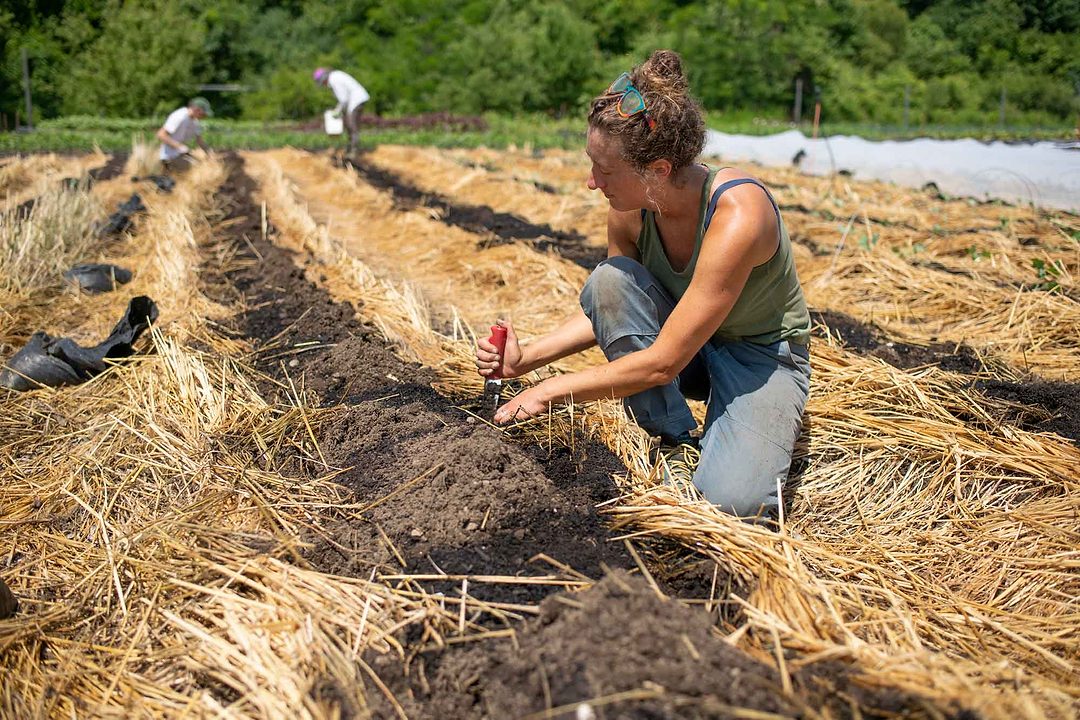A well-known tale professes good farmers grow great vegetables, but great farmers grow superb soil. Gaining Ground has superb soil.
Since its inception 27 years ago, Gaining Ground has consistently met its mission of ‘providing equitable access to healthy food and sustainably grown produce.’ The key to their success is a supportive board, an outstanding office team, knowledgeable farm staff, and a dedicated volunteer crew. Together, using three acres of farmland, they grow approximately 100,000 pounds of produce annually, serving 1,200 households weekly.

Aerial photo of Gaining Ground
| courtesy of Gaining GroundEffective management and a seamless process from soil care, planting cycles, harvest, and, finally, delivery of the produce to their partners is only part of their success. The other piece is their individual affinity toward the organization
Executive Director Jennifer Johnson brings a level of savviness from the business perspective and a genuine element of kindness on the ‘affinity’ side. She has matured the organization while keeping its roots firmly planted in its mission. “Healthy soil produces healthier plants. This, in turn, lessens the pest and weed pressure. If there are fewer weeds taking the nutrients, then the crops tend to be healthier.”
No-till farming is key to Gaining Ground. In 2016 the farm converted to this system which means they disturb the soil as little as possible. No-till means that the soil is not churned up when crops are planted. Rather, existing trenches are used to plant the seed. Johnson shares, “The key is to minimize soil damage by keeping the innate soil biology and microorganisms undisturbed in the soil which feed the crops. What that translates to is healthy soils providing healthier food.” In addition, no-till agriculture makes soil able to absorb water more readily. Even with heavy rains, there tends to be little standing water because the soil absorbs water easier than tractor-tilled fields.

School lunches prepared with Gaining Ground produce
| Courtesy of Gaining GroundFarm Manager Anna Kelchlin oversees the entire farm, ensuring crops are rotated to balance nutrient uptake. She notes that tomatoes and peppers are heavy feeders. Lettuce, however, does not take up as many nutrients, partly because this crop is not in the ground as long as some other vegetables. She balances soil health by rotating crops and using organic fertilizers such as kelp meal, feather meal, and biochar. She orchestrates different amounts of additives based on soil need. Keeping to the no-till method, these fertilizers are added without soil disruption. The reason Kelchlin is keen on testing the soil and amending the nutrients is because if soil is healthy, plants can better fight off pests.
The affinity part of Kelchlin’s draw to the farm is quite personal. Twelve years ago, she had a heart transplant. She shares, “For me, working at Gaining Ground is giving back life by taking care of the earth and also nourishing other people.” Her current team of eight farmers happen to all be women and each has their area of focus, such as maintaining the green house and wash station, growing flowers and herbs, maintaining irrigation, overseeing markets, etc. She finds it invigorating to see everyone work together toward a common goal.
In order to harvest 100,000 pounds of produce you need many hands. The farm has over 2,000 volunteers who work with the farmers. One of the dedicated volunteers who has been there from the beginning is Christine Lundblad, who is at the farm at least once a week. Every day she is there the work is a bit different; from planting to harvesting to weeding and organizing. She also enjoys working alongside the lead farmers as she learns new techniques that she uses in her own gardens at home. “I learn something new every time I go. Sometimes I learn more about soil preparation or how to cultivate a specific vegetable or even the correct way to use a type of hoe.” She also noted that she appreciates seeing the care with which the harvest is processed. Volunteers are instructed not to toss tomatoes into a bin but instead place them in the bin, so as not to bruise them.

Hoop houses and the barn
| Courtesy of Gaining GroundThe draw to the farm for Lundblad is a sense of purpose. She retired from the workplace in 2019 to help take care of her mom. While retired, Lundblad wanted to remain active and do meaningful work within her community. One of her very good friends is Polly Vanasse, the current board president. Vanasse and others began the Gaining Ground farm some 27 years ago and Lundblad joined in at that time, delivering food to those in need. As the organization grew, both Vanasse and Lundblad’s connection and conviction to the organization grew as well. Vanasse states, “I am a career educator, my teaching passion was service learning. Of all the projects I have ever done, Gaining Ground is the most significant and substantial.” She works with middle school students, making them a part of the solution for those with food insecurity. She continues, “The students seem to be at their best when they are doing something for someone else. Teaching the students that one person can make a difference and then actually having the students each make a difference by helping at the farm is impactful.”
Currently, there are 18 organizations in Eastern Massachusetts that are recipients of Gaining Ground’s bounty, including food pantries, schools, homeless shelters, and meal programs. The produce they receive is stunningly fresh, organic, and simply beautiful. Guy Koppe, head chef at the Boston Charter School in Roxbury, is continually amazed by the quality of the food. “A chef at any high-end Boston restaurant would be thrilled to get this type of produce.” Produce from Gaining Ground has quite a bit of diversity. Sometimes he receives Japanese turnips, hakurei, bok choy, sweet snap peas, or colorful carrots. This wide range of produce offers an opportunity to introduce students to new vegetables.
Often he thinks, “What am I going to do with this?” Soon after, the stove is sizzling with baby bok choi sauteing in olive oil, salt, and pepper with a bit of garlic, a dash of soy sauce, and a generous amount of chicken stock. He also finds the colors of the produce to be so vibrant that the students are eager to try it, even if they are not used to it. Koppe states that they will devour a watermelon radish because of how fresh it looks and tastes. He believes that healthy nourishment every day in school begins a trend, potentially a lifelong trend, of healthy eating.
Healthy eating for everyone is central to what Gaining Ground represents. At the heart of things, helping others is front and center. Kindness is evident as Johnson shares, “Everyone deserves equitable access to nutritional foods to live a healthy life. Hunger is a nutrition problem not a calorie problem. Produce is amongst the most expensive items at the grocery. We can help solve this.”
Visit gainingground.org to volunteer, make a donation, or find more information.


